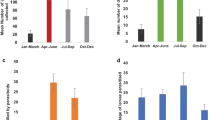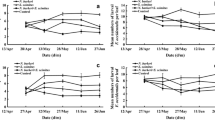Abstract
Developing integrated pest management practices against the defoliating beetle Mesoplatys ochroptera is an important aspect of the adoption of Sesbania sesban as an improved fallow species in southern Africa. The effect of defoliation by M.ochroptera on the growth of S. sesban(provenance Kakamega) was studied during 1998–2000 at Msekera Research Station in eastern Zambia. To determine the relationship between M. ochroptera densities and degree of defoliation, potted seedlings were infested manually with different densities of larvae and adults. Infestation of two to three month old seedlings with 5–30 larvae or adults resulted in less than 20% defoliation. Infestation of seedlings with 90–150 larvae(>3 masses of eggs) led to 80–100% and 50–80% defoliation in two and three months old seedlings, respectively. The time of infestation and degree of defoliation that lead to reduction in growth and biomass were determined using simulated (manual) defoliation of one to three months old S. sesban seedlings. Manual removal of 50–100% of the foliage atone and two months after transplanting (MAP) appeared to reduce plant height, basal diameter, primary branches, leaf and wood biomass compared to that done atthree MAP. Removal of 25–50% of the sesbania foliage three months after transplanting apparently leads to overcompensation. In sesbania, compensatory growth occurred when 25–50% of the leaves were defoliated three months after transplanting. Therefore, farmers need to protect sesbania seedlings from defoliation against insects such as M. ochroptera only during the first two months after transplanting.
Similar content being viewed by others
References
Alfaro R.I. 1991. Damage assessment and integrated pest management of forest defoliators. Forest Ecology and Management 39: 275-281.
Alward R.D. and Joern A. 1993. Plasticity and overcompensation in grass responses to herbivory. Oecologia 95: 358-364.
Brook K.D., Hearn A.B. and Kelly C.F. 1992a. Response of cotton, Gossypium hirsutum L., to damage by insect pests in Australia: Manual simulation of damage. Journal of Economic Entomology 85: 1368-1377.
Brook K.D., Hearn A.B. and Kelly C.F. 1992b. Response of cotton to damage by insect pests in Australia: Compensation for early season fruit damage. Journal of Economic Entomology 85: 1378-1386.
Dent D. 1991. Insect Pest Management. CAB International, Wallingford, 604 pp.
Dyer M.I., Turner C.L. and Seastedt T.R. 1993. Herbivory and its consequences. Ecological Applications 3: 10-16.
Escarre J., Lepart J. and Sentuc J.J. 1996. Effects of simulated herbivory in three old field compositae with different inflorescence architectures. Oecologia 105: 501-508.
Hjältén J., Danell J. and Ericson L. 1993. Effect of simulated her-bivory and interspecific competition on the compensatory ability of birches. Ecology 74: 1136-1142.
Kwesiga F. and Coe R. 1994. The effect of short rotation Sesbania sesban planted as fallows on maize. Forest Ecology and Management 64: 199-209.
Kwesiga F.R., Franzel S., Place F., Phiri D. and Simwanza C.P. 1999. Sesbania sesban improved fallows in eastern Zambia: their inception, development and farmer enthusiasm. Agroforestry Systems 47: 49-66.
Matungulu M.K. 1994. Soils and Climates: Southern African AFRENA Research Sites. ICRAF, Nairobi, 272 pp.
Paige K.N. 1992. Overcompensation in response to mammalian herbivory: From mutualistic to antagonistic interactions. Ecology 73: 2076-2085.
Paige K.N. and Whitham T.G. 1987. Overcompensation in response to mammalian herbivory: The advantage of being eaten. American Naturalist 129: 407-416.
Pfeiffer R. 1990. Sustainable agriculture in practice-the production potential and the environmental effects of macro-contour-line in the West Usambara Mountains of Tanzania. PhD Dis-sertation, University of Hohenheim, Germany.
SAS Institute 1996. SAS/STAT, Release 6.12. SAS Institute Inc., Cary, NC.
Sileshi G.W. 2000. Studies on Insect Pests of Sesbania sesban with Special Emphasis on Mesoplatys ochroptera (Coleoptera: Chrysomelidae) in Improved Fallows. PhD Dissertation, Kenyatta University, Nairobi, Kenya.
Sileshi G., Maghembe J.A., Rao M.R., Ogol C.K.P.O. and Sithanantham S. 2000. Insects feeding on Sesbania species in natural stands and agroforestry systems in southern Malawi. Agroforestry Systems 49: 41-52.
Sileshi G., Ogol C.K.P.O., Sithanantham S., Rao M.R., Baumgaertner J., Maghembe J.A. et al. 2001. Resistance of Sesbania ac-cessions to Mesoplatys ochroptera Stål (Chrysomelidae: Coleoptera). Insect Science and its Application 21: 139-153.
Sileshi G. and Mafongoya P.L. 2002. Incidence of Mesoplatys ochroptera stål (Coleoptera: Chrysomelidae) on Sesbania sesban in pure and mixed species fallows in eastern Zambia. Agro-forestry Systems (in press).
Simmons A.M. and Yeargan K.V. 1990. Effect of combined injuries from defoliation and green stinkbug (Hemiptera: Pentatomidae) and influence of field cages on soybean yield and seed quality. Journal of Economic Entomology 83: 599-609.
Trumble J.T., Kolodny-Hirsh D.M. and Ting I.P. 1993. Plant compensation for arthropod herbivory. Annual Review of Entomology 38: 93-119.
Turner C.L., Saestedt T.R. and Dyer M.I. 1993. Maximization of aboveground grass production: The role of defoliation frequency, intensity, and history. Ecological Applications 3: 175-186.
Waddill H. Van, Phoronezny K., Mcsorley R. and Bryan H.H. 1984. Effect of manual defoliation on pole bean yield. Journal of Economic Entomology 77: 1019-1023.
Wale M., Abate T. and Tesfaye A. 1996. Getting to know the enemy-Mesoplatys beetles and Sesbania. Agroforestry Today 8(3): 17-18.
Author information
Authors and Affiliations
Corresponding author
Rights and permissions
About this article
Cite this article
Sileshi, G., Mafongoya, P. & Kwesiga, F. Performance of Sesbania sesban infested by the defoliating beetle Mesoplatys ochroptera in Zambia. Agroforestry Systems 56, 177–184 (2002). https://doi.org/10.1023/A:1021310312694
Issue Date:
DOI: https://doi.org/10.1023/A:1021310312694




